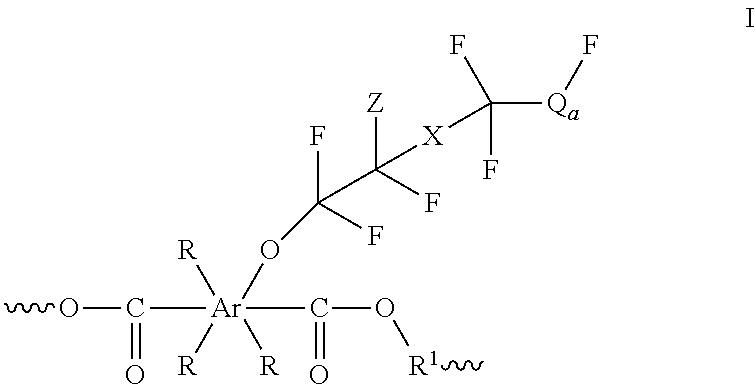Polyesters comprising fluorovinylether functionalized aromatic moieties
a technology of fluorovinylether and aromatic moieties, applied in the field of polymer polymers, can solve problems such as the reduction of their effectiveness
- Summary
- Abstract
- Description
- Claims
- Application Information
AI Technical Summary
Problems solved by technology
Method used
Image
Examples
example 1
Homo-Polyester of Dimethyl 2-(1,1,2-trifluoro-2-(1,1,2,3,3,3-hexafluoro-2-(perfluoropropoxy)propoxy)ethoxy)terephthalate and 1,3-propanediol
[0130]Dimethyl 2-(1,1,2-trifluoro-2-(1,1,2,3,3,3-hexafluoro-2-(perfluoropropoxy)propoxy)ethoxy)terephthalate (64.2 g, 0.10 mol), 1,3-propanediol (19.00, 0.25 mol) and titanium n-butoxide (0.34 g, 0.001 mol) were charged into a oven dried three neck reaction flask equipped with a mechanical stirrer, thermocouple and a vigreux column, attached to a distillation head, with receiving flask, to form a reaction mixture. The resulting mixture was heated to 180° C., then to 225° C. over 50 minutes and then to 250° C. over 90 minutes. At this point the material was yellow in color. Vacuum was applied to the reaction, causing the temperature to fall to 214° C. Over the next 40 minutes the temperature recovered to 226° C. with a vacuum of 0.60 torr and attained 248° C. over the next 25 minutes with the vacuum holding at 0.7 torr, wherein lighter components...
example 2
Co-Polyester of Dimethyl 2-(1,1,2-trifluoro-2-(1,1,2,3,3,3-hexafluoro-2-(perfluoropropoxy)propoxy)ethoxy)terephthalate, dimethyl terephthalate and 1,3-propanediol
[0131]Dimethyl 2-(1,1,2-trifluoro-2-(1,1,2,3,3,3-hexafluoro-2-(perfluoropropoxy)propoxy)ethoxy)terephthalate (31.1 g, 0.05 mol), dimethyl terephthalate (9.7 (0.05)1,3-propanediol (19.00, 0.25 mol) and titanium n-butoxide (0.34 g, 0.001 mol) were charged into a oven dried three neck reaction flask equipped with a mechanical stirrer, thermocouple and a vigreux column, attached to a distillation head, with receiving flask, to form a reaction mixture. The reaction mixture was heated to 200° C., then held at that temperature for 60 minutes, then heated to 225° C. over 30 minutes, then held at that temperature for 20 minutes, and then to 250° C. over 40 minutes, then held at that temperature for an hour, wherein lighter components (e.g., methanol, excess 1,3-propanediol) were distilled over to a distillation flask. At this point ...
example 3
Copolymerization of 1,3-propanediol with dimethyl 2-(1,1,2-trifluoro-2-(perfluoropropoxy)ethoxy) terephthalate, and dimethyl terephthalate
[0132]Dimethylterephthalate (DMT, 130 g, 0.66 mol), dimethyl 2-(1,1,2-trifluoro-2-(perfluoropropoxy)ethoxy) terephthalate (weight percent relative DMT), and 1,3-propanediol (90.4 g, 1.19 mol, 1.8 eq to DMT) were charged to a pre-dried 500 mL three necked round bottom reaction flask. An overhead stirrer and a distillation condenser were attached. The reactants were stirred at a speed of 50 rounds per minute (rpm), the reaction mixture was kept under nitrogen(g) (N2) purge atmosphere and the condenser was kept at 23° C. The reaction mixture was degassed three times by evacuating down to 100 Torr and refilling back with N2 gas. Tyzor®TPT catalyst [50 ppm Ti to theoretical polymer yield, δTYZOR=0.96 g / mL] was added to the reaction flask after the first evacuation. The reaction flask was immersed into a preheated metal bath set at 160° C. The solids in...
PUM
| Property | Measurement | Unit |
|---|---|---|
| Structure | aaaaa | aaaaa |
| Electrical resistance | aaaaa | aaaaa |
Abstract
Description
Claims
Application Information
 Login to View More
Login to View More - R&D
- Intellectual Property
- Life Sciences
- Materials
- Tech Scout
- Unparalleled Data Quality
- Higher Quality Content
- 60% Fewer Hallucinations
Browse by: Latest US Patents, China's latest patents, Technical Efficacy Thesaurus, Application Domain, Technology Topic, Popular Technical Reports.
© 2025 PatSnap. All rights reserved.Legal|Privacy policy|Modern Slavery Act Transparency Statement|Sitemap|About US| Contact US: help@patsnap.com



